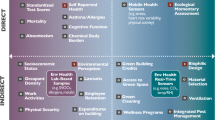Abstract
During the early design stage of green residential buildings, there are tremendous potential of using parametric optimization to achieve preferable green performance, such as building energy consumption efficiency, daylighting, ventilation and thermal comfort. Taking residential design features into consideration, this paper presents an optimization workflow and effects based on a case study of a residential building project in Beijing. Firstly, 27 design parameters related to residential spatial form and building envelope were selected for the optimization. The simulation results of the cooling and heating load were taken as the optimization objects. Secondly, optimized schemes were obtained from 6246 simulation results, with 1925 verified simulation results proving that the optimized result is reliable. Finally, analysis was performed to establish the correlations between design parameters and performance in order to create the easy access for architects to determine design parameters depending on the performance sensitivity of each parameter. Analysis results showed that parametric optimization of spatial form and building envelope at the design stage is a feasible approach to reducing energy consumption in residential building design.
Similar content being viewed by others
References
Arora JS (2006). Jan A. Snyman, Practical Mathematical Optimization: An introduction to basic optimization theory and classical and new gradient-based algorithms. Structural and Multidisciplinary Optimization, 31: 249.
Bamdad K, Cholette ME, Guan L, Bell J (2018). Building energy optimisation under uncertainty using ACOMV algorithm. Energy and Buildings, 167: 322–333.
Bi X, Liu C (2018). Parametric design of energy efficiency through ladybug + honeybee—A case study on the design of office complexes in cold regions in China. Architectural Journal, 2018(2): 44–49. (in Chinese)
Bichiou Y, Krarti M (2011). Optimization of envelope and HVAC systems selection for residential buildings. Energy and Buildings, 43: 3373–3382.
de Wilde P, van der Voorden M (2004). Providing computational support for the selection of energy saving building components. Energy and Buildings, 36: 749–758.
Evins R (2013). A review of computational optimisation methods applied to sustainable building design. Renewable and Sustainable Energy Reviews, 22: 230–245.
Grijalva K (2012). Associative design for building envelopes’ sun control and shading devices. Master Thesis, Arizona State University, USA.
Guo F (2013). The application of Geco in the design of parametric building energy-saving—Case study of the National Library of Kazakhstan Astana. Urbanism and Architecture, 2013(6): 222. (in Chinese)
Hamdy M, Hasan A, Siren K (2011). Applying a multi-objective optimization approach for design of low-emission cost-effective dwellings. Building and Environment, 46: 109–123.
Jin M (2012). Folding conception, Nomadic space: A research on generating design and its spatial character in digital architecture. PhD Thesis, Tsinghua University, China. (in Chinese)
Jin JT, Jeong JW (2014). Optimization of a free-form building shape to minimize external thermal load using genetic algorithm. Energy and Buildings, 85: 473–482.
Kim J, Yi YK, Malkawi AM (2011). Building form optimization in early design stage to reduce adverse wind condition—Using computational fluid dynamics. In: Proceedings of the 12th International IBPSA Building Simulation Conference, Sydney, Australia, pp. 785–791.
Konis K, Gamas A, Kensek K (2016). Passive performance and building form: An optimization framework for early-stage design support. Solar Energy, 125: 161–179.
Li Z, Chen H, Lin B, Zhu Y (2018). Fast bidirectional building performance optimization at the early design stage. Building Simulation, 11: 647–661.
Lin BR, Li ZW (2016). Building energy-saving approach in early design stage. Chinese Science Bulletin, 61: 113–121.
Livingston M (2002). Watergate: The name that branded more than a building. Washington Business Journal, 17 June.
Ma Q, Fukuda H (2016). Parametric office building for daylight and energy analysis in the early design stages. Procedia — Social and Behavioral Sciences, 216: 818–828.
MHURD (2005). GB50352-2005, Code for Design of Civil Buildings. Ministry of Housing and Urban-Rural Development of China (in Chinese)
Mitchell M (1996). An Introduction to Genetic Algorithms. Cambridge, MA, USA: MIT Press.
Negendahl K, Nielsen TR (2015). Building energy optimization in the early design stages: A simplified method. Energy and Buildings, 105: 88–99.
Nguyen AT, Reiter S, Rigo P (2014). A review on simulation-based optimization methods applied to building performance analysis. Applied Energy, 113: 1043–1058.
Rutten D (2013). Galapagos: on the logic and limitations of generic solvers. Architectural Design, 83: 132–135.
Schleicher S, Santos L, Caldas L (2018). Data-driven shading systems—Application for freeform glass facades. In: Proceedings of Facade Tectonics World Congress, Los Angeles, CA, USA.
Si B, Wang J, Yao X, Shi X, Jin X, Zhou X (2019). Multi-objective optimization design of a complex building based on an artificial neural network and performance evaluation of algorithms. Advanced Engineering Informatics, 40: 93–109.
Sun C, Han Y (2016). A study on energy-saving design of office building forms in the severe cold region regarding daylighting and thermal performance. Architectural Journal, 2016(2): 44–48. (in Chinese)
Sutherland I (1963). Sketchpad: A Man-Machine Graphical Communication System. PhD Thesis, Massachusetts Institute of Technology.
Teresko J (1993). Parametric Technology Corp.: Changing the way products are designed. Industry Week, December 20.
Toutou A, Fikry M, Mohamed W (2018). The parametric based optimization framework daylighting and energy performance in residential buildings in hot arid zone. Alexandria Engineering Journal, 57: 3595–3608.
Wang W, Zmeureanu R, Rivard H (2005). Applying multi-objective genetic algorithms in green building design optimization. Building and Environment, 40: 1512–1525.
Acknowledgements
This research is supported by the National Key R&D Program of China (No. 2016YFC0700200).
Author information
Authors and Affiliations
Corresponding author
Rights and permissions
About this article
Cite this article
Zhang, J., Liu, N. & Wang, S. A parametric approach for performance optimization of residential building design in Beijing. Build. Simul. 13, 223–235 (2020). https://doi.org/10.1007/s12273-019-0571-z
Received:
Revised:
Accepted:
Published:
Issue Date:
DOI: https://doi.org/10.1007/s12273-019-0571-z




